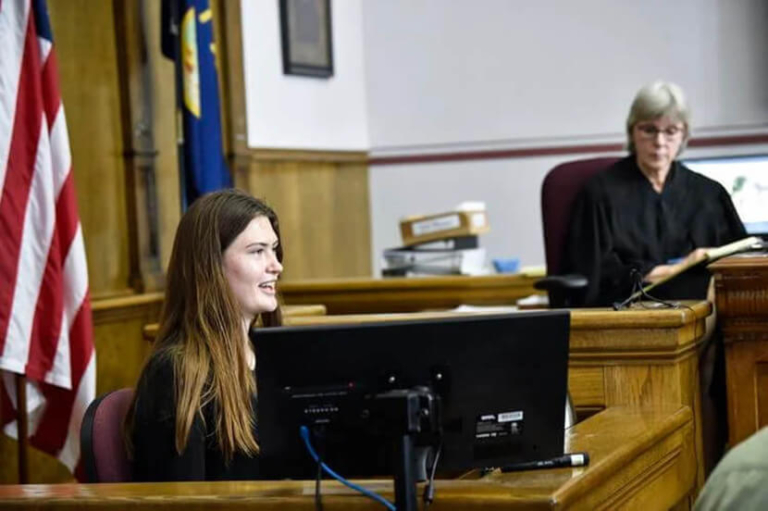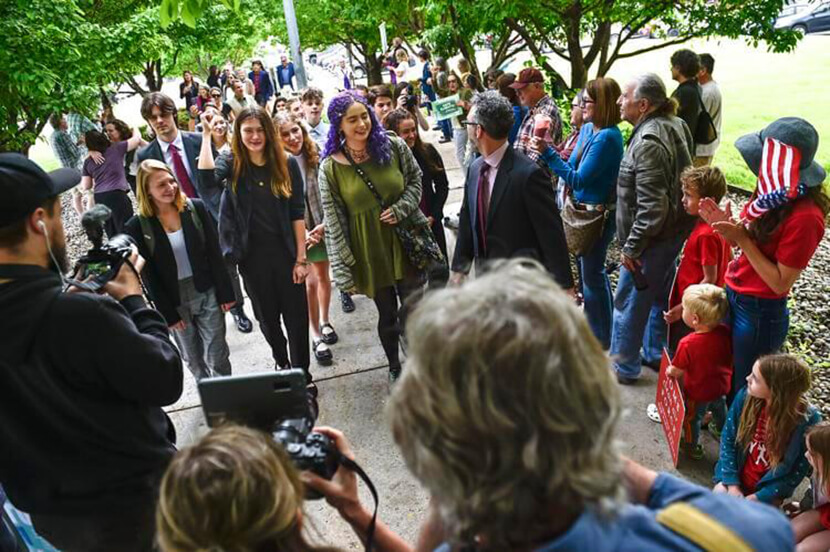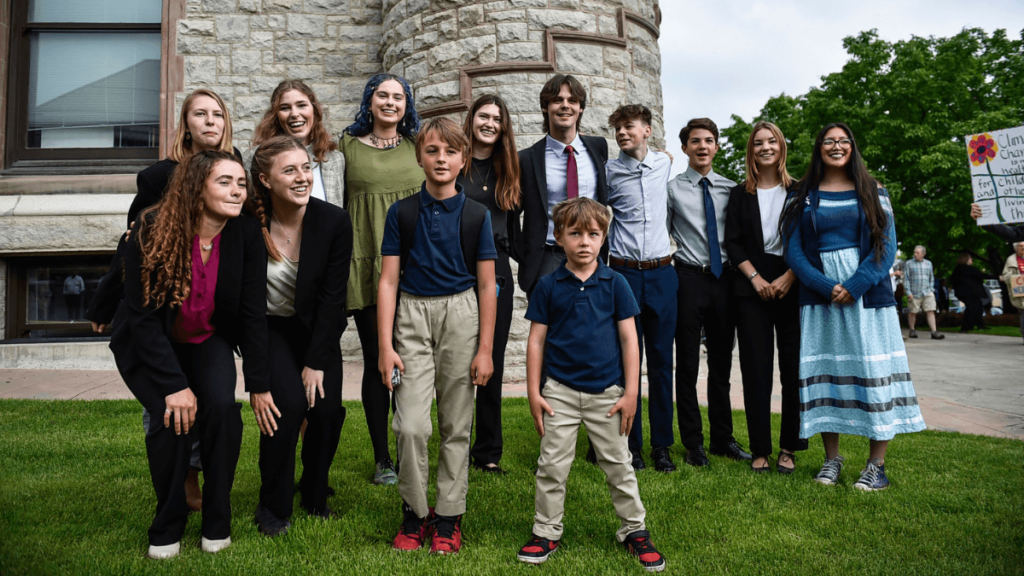Casebook Info
Facing heartbreaking environmental changes, 16 youth demanded the full realization of their constitutional right to a safe and healthful environment. After the first ever rights-based climate trial in the United States, the Montana trial court ruled that Montana’s fossil-fuel friendly law was unconstitutional.
In a striking opinion, the court held that the law violated the youth plaintiffs’ right to a clean and healthful environment because it facilitated significant greenhouse gas emissions. The court concluded that the young plaintiffs were already experiencing harmful impacts from climate change, and that they would disproportionately face further harms as the crisis worsens. The decision will serve as a powerful precedent for future rights-based climate litigation.
- Year Filed 2020
- Year of Most Recent Ruling 2023
- Year of Final Ruling 2023
- Jurisdiction Montana
- Court Name Montana District Court
- Primary Focus Mitigation & State Constitutional Duties on Climate Change
- Ruling On Merits
- Plaintiff(s) Sixteen youth
- Respondent(s) State of Montana
- Outcome N/A
- Organizational leader of the litigation Our Children’s Trust
- Link to the decision/ruling
Background
In 2020, 16 Montana youth—then aged two through 18—boldly took on the Montana state government’s pro-fossil fuel policies. The plaintiffs challenged the Montana State Energy Policy and a provision of the Montana Environmental Policy Act (MEPA), known as the MEPA Limitation, which prohibited state agencies from climate change in their environmental reviews. The plaintiffs argued that these laws violated their state constitutional right to a “clean and healthful environment” by perpetuating a fossil fuel-based energy system that drives the climate crisis. They also argued that the state violated their rights to seek safety, health, and happiness and their rights to individual dignity and equal protection of the law. Lastly, the plaintiffs asserted that the state’s energy policies unconstitutionally depleted the state’s rivers, lakes, wildlife, and atmosphere, all of which must be held in the public trust.
Background
Montana’s constitution holds some of the most protective environmental rights provisions in the country. Article II, § 3 of the state constitution enshrines the inalienable right to “a clean and healthful environment,” while the constitution’s preamble and Article IX stipulate that the state and individuals are responsible for maintaining the environment “for present and future generations.” Interpreting these provisions, the Montana Supreme Court held in 1999 that the right to a clean and healthful environment is a “fundamental right,” which means that courts must closely review any law that allegedly violates the right. This type of judicial review, which is also known as “strict scrutiny,” provides the highest level of protection for constitutional rights. Thus, Montana’s recognition of fundamental environmental rights— along with the government’s harsh anti-climate policies—made the state an ideal site for youth-led climate litigation.
Montana, which has substantial fossil fuel reserves, has long had a robust fossil fuel economy. The state has 5,000 gas wells, 4,000 oil wells, four oil refineries and six coal mines. In 2011, Montana government took action to protect fossil fuel interests in the state. The Montana legislature amended MEPA, the state’s environmental protection law, to bar state agencies from considering “regional, national, or global” environmental impacts when conducting environmental reviews or evaluating whether to issue new permits for fossil fuel projects.
The Complaint and Pretrial Motions
In their complaint, the plaintiffs asked the court for 1) a declaratory judgement stating that their rights had been violated by the Montana State Energy Policy and MEPA Limitation, and 2) an injunction ordering the state to reduce carbon emissions and provide an accounting of said emissions. They argued that the Montana State Energy Policy “involves systemic authorization, permitting, encouragement, and facilitation of activities promoting fossil fuels . . . resulting in dangerous levels of greenhouse gas emissions, without regard to climate change impacts or the fundamental rights of Youth Plaintiffs and future generations” (Complaint, p. 34). The complaint also asserted that the MEPA Limitation had helped to facilitate dangerous levels of greenhouse gas (GHG) emissions by requiring the government to ignore climate change while implementing the fossil fuel friendly policy.
In response, the Montana government “pulled out all the stops” to prevent the plaintiffs from getting a trial. First, the state asked the court to dismiss the case. The court agreed to dismiss the plaintiffs’ claims for injunctive relief, holding that the requested injunction was a political issue for the political branches of government. (This is known as the “political question doctrine.”) But the court declined to dismiss the plaintiffs request for a declaratory judgement. In its order, the court concluded that the plaintiffs had standing to challenge the MEPA Limitation and State Energy Policy.
Dissatisfied, the state government filed a Petition for Writ of Supervisory Control, which asked the Montana Supreme Court to take control of the case. The Montana high court rejected this request, and the case moved toward trial.
In March 2023, the Montana government repealed the State Energy Policy. And a few months later, the government doubled down on the “climate change exception” to MEPA. Responding to a different court decision, the legislature clarified that state agencies were prohibited from considering GHG emissions and “corresponding impacts on the climate” (Mont. Code Ann. § 75-1-201(2)(a), amended by H.R. 971).
The government lawyers repeatedly asked the district court to throw out the youth plaintiffs’ case. The district court agreed to dismiss the State Energy Policy claims, since the law had been repealed. But in a groundbreaking decision, the court decided that the plaintiffs had a case worthy of trial. The state filed an Emergency Petition for Writ of Supervisory Control with the Montana Supreme Court, but the high court rejected the request for the second time.
The First Rights-Based Climate Trial
Held v. Montana was the first youth-led climate trial in the U.S. Unsurprisingly, it was also the first U.S. trial on the rights implications of climate change. The youth advocates spoke about how they were impacted by climate change. They spoke of their love for Montana’s wilderness, and their sadness at the changing environment. Members of the Crow, an Indigenous tribe in Montana, testified about losing cultural heritage because of wildfires, heavy rains, and environmental changes.

The advocates also brought a host of experts to support their case. Dr. Steven Running, former member of the Intergovernmental Panel on Climate Change, described how the climate crisis has contributed to the increasing severity and frequency of extreme weather events in Montana and the world. Clinical Psychiatrist Lise Van Susteren spoke about how the youth plaintiffs are experiencing “pretraumatic stress” from the climate crisis. Researcher Peter Erikson explained that Montana emits more GHG emissions than some countries; in 2019, the state polluted the atmosphere as much as the entire country of Ireland. And Dr. Mark Jacobson described how the state could transition away from fossil fuels.
Overall, the youth plaintiffs presented 24 witnesses. The state only provided three, ending the trial three days earlier than expected.
The District Court Decision
On August 14, 2023, Judge Kathy Seeley delivered the opinion of the district court.
First, Judge Seeley concluded that the youth plaintiffs had “experienced past and ongoing injuries resulting from [Montana’s] failure to consider GHGs and climate change, including injuries to their physical and mental health, homes and property, recreational, spiritual, and aesthetic interests, tribal and cultural traditions, economic security, and happiness” (p. 86). She emphasized that the plaintiffs’ feelings of “loss, despair, and anxiety” were recognizable mental health injuries, worthy of redress (p. 87). She further noted that, as children and youth, the plaintiffs “are disproportionately harmed by fossil fuel pollution and climate change” (p. 87).
Next, she determined that Montana’s “globally significant” GHG emissions “cause and contribute to climate change” (p. 88). The MEPA Limitation directly facilitates these emissions because it “causes the State to ignore renewable energy alternatives to fossil fuels.” (At 81) And, “every additional ton of GHG emissions exacerbates [the plaintiffs’] injuries and risks locking in irreversible climate injuries” (p. 87). Thus, the Montana government can partially alleviate the youth plaintiffs’ suffering, “if [state agencies] are allowed to consider GHG emissions and climate change” in their environmental reviews (p. 88-89). Judge Seeley noted that Montana still has large fossil fuel reserves that could be approved for extraction if the MEPA Limitation prevents the state from considering climate change (p. 89).
Finally, the court determined that the MEPA Limitation violates the plaintiffs’ constitutional right to a clean and healthful environment. This right is a “forward-looking” right, which requires the state to take “active steps” to realize the right and prevent environmental degradation before it happens (p. 96). So, Judge Seeley concluded, the MEPA Limitation directly violates this right by “contributing to the depletion and degradation of Montana’s environment and natural resources.”
For an inside perspective on this case, listen to our conversation with Phil Gregory, attorney at Our Children’s Trust and counsel for the plaintiffs in Held.
- 2.5 degrees Montana’s average temperatures have risen nearly 2.5 degrees since the beginning of the 20th century (more than 2x the global average)
- 350 ppm The plaintiffs are asking the Court to declare 350 ppm as the constitutional standard necessary to ensure “the stable climate system”
- Art. II § 3 Provision of the Montana Constitution, which enshrines the inalienable right to “a clean and healthful environment”
- $95 million How much wildfires cost Montana in 2018
- 30.5 million metric tons how much CO2 was emitted in Montana in 2018
- 14.6% The amount of energy produced in Montana from renewable resources in 2017
- 88% percentage of those currently suffering from diseases caused by climate disruption under the age of 18
Strategies
Focusing on youth and future generations

Held was brought by a group of 16 youth plaintiffs and supported by Our Children’s Trust, a non-profit organization dedicated to defending the climate rights of youth across the United States. The plaintiffs made their youth, and the rights of future generations, a central part of their case. In the complaint, they argued that when the “political majority places [] children in harm’s way and at substantial risk to their lives and security, [youth] are dependent on the judiciary to vindicate and protect their fundamental and inalienable constitutional rights” (p. 3-4). The court ultimately agreed that climate change disproportionately harms young people, since the crisis will continue to worsen over time. The court also took seriously the mental health impact climate change has on young people.
Centering rights

The case rests on the plaintiffs’ constitutional rights, particularly the right to a safe and healthful environment. The plaintiffs creatively argued that this right includes “the right to a stable climate system.” By invoking a fundamental right, the plaintiffs were able to ask the court to apply a high level of scrutiny to the MEPA Limitation. This high level of scrutiny meant that the MEPA Limitation needed to be better justified than most laws. By focusing on rights, the youth plaintiffs were able to frame climate change as an issue for the courts rather than the political branches of government. Ultimately, the decision in Held substantially advances both climate law and environmental rights law in the U.S.
Takeaways
The right to a healthy environment can be a powerful tool for climate action.
This case shows how the right to a healthy environment— which is recognized by the U.N. and constitutions around the world— can be used to hold governments accountable for allowing GHG emissions. The court rested its decision entirely on the plaintiffs’ right to a clean and healthful environment, showing an expansive understanding of the right. The court interpreted the right to bar action or inaction that poses a substantial threat to the climate system. This decision will serve as crucial precedent for other courts considering the right to a healthy environment.
Litigating existing climate-related impacts may be more viable than litigating prospective climate-related impacts, and bringing the former alongside the latter may strengthen both claims. Establishing current and past harms from climate change helped the youth plaintiffs prove that their claims were concrete rather than speculative. The speculative nature of future climate impacts has been a common barrier to standing in other climate lawsuits. Pointing to ongoing and past harms also helped the plaintiffs emphasize the urgency of the crisis, since experts testified that these harms will only worsen over time.
The fact that many individuals may experience similar climate-related harms does not prevent the plaintiffs from bringing a claim. A common hurdle in climate-related cases is the requirement that a plaintiff’s injuries be concrete and sufficiently particularized, which has sometimes been interpreted to mean that the injury must be unique, fully realized, or clearly inevitable. Here, however, it was not dispositive that other Montanans likely experienced similar injuries. The Court held to a broader understanding of the requirement, finding: “To deny standing to persons who are in fact injured simply because many others are also injured, would mean that the most injurious and widespread government actions could be questioned by nobody” (Order on Motions to Dismiss for Mootness and Summary Judgement, p. 7).
Bringing constitutional claims, when available, helps to circumvent procedural obstacles. Procedural impediments have proven fatal to many climate-related and youth-driven suits, such as those dismissed for lack of standing or failure to exhaust administrative remedies. The constitutional claims in Held helped to guard against these procedural barriers. The fundamental nature of the right to a clean and healthful environment allowed the case to survive attacks on both standing and admissibility, in addition to discrediting several of the state defendants’ key arguments. The court held that the youth plaintiffs did not need to exhaust their administrative remedies because they were alleging violation of their fundamental rights.
Impacts
Held has been hailed as the first major legal victory for the youth-led climate movement in the U.S. The decision sets a significant precedent for future climate litigation in Montana and other U.S. states. It is the first decision in the U.S. to recognize the connection between climate change and human rights, a connection that has been recognized by many other courts around the world. The youth plaintiffs’ central claim can be replicated anywhere that recognizes the right to a healthy environment. Indeed, this decision may serve as precedent in other countries, as courts consider how climate change impacts the right to a healthy environment. The Held decision also addresses and dismisses many of the arguments used by governments in other climate lawsuits.
While the Montana government has promised to appeal the district court’s decision, some commentators are hopeful that the Montana Supreme Court may rule in favor of the youth plaintiffs.
This case will also likely strengthen the youth-led climate movement. The youth plaintiffs successfully used the case to rally supporters and generate significant media attention. Held highlights the crucial role that young people are playing in the fight to preserve the Earth’s climate. The case will inspire other young people to challenge climate inaction and injustice.

Credit: Thom Bridge / Independent Record
In Montana, the Held ruling guides Montana agencies to consider GHG emissions and climate change in their environmental reviews. While the state legislature may attempt to reinforce the state’s commitment to fossil fuels, the court’s decision will likely limit the legislature’s options. The Held decision established for the first time ever that climate change is covered by the Montana Constitution, and it affirmed the government’s duty to affirmatively protect and preserve Montana’s nature. In time, this decision will hopefully limit fossil fuel extraction in Montana.

